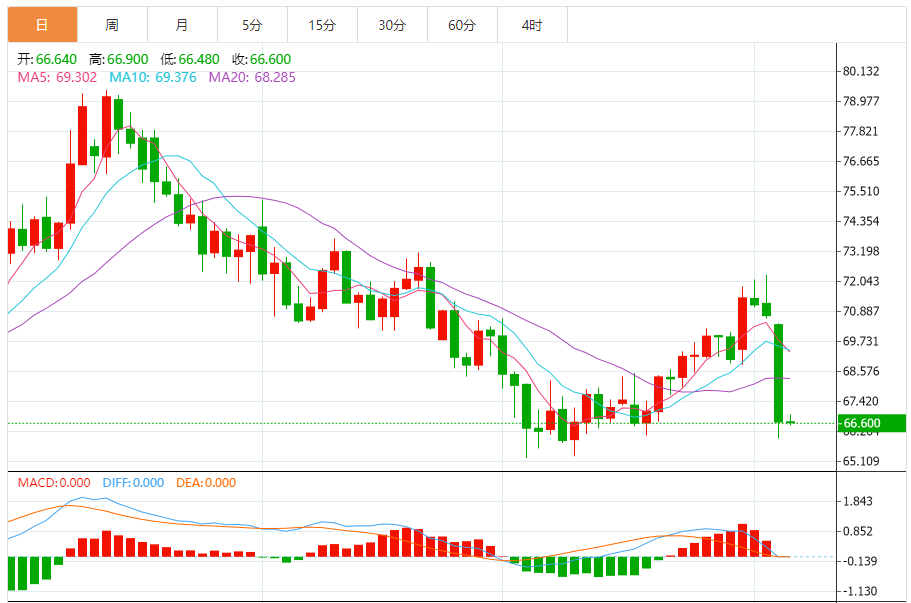On Friday (April 4), international oil prices fluctuated in a narrow range, and US crude oil is currently trading around $66.59 per barrel. International oil prices suffered a "Black Thursday" on Thursday, setting the worst single-day drop in three years. Brent crude oil plummeted 6.42% to $70.14 per barrel, and WTI crude oil plummeted 6.64% to $66.95 per barrel, both setting a record for the largest drop since 2022. This plunge was jointly detonated by three "depth bombs": OPEC+ suddenly reversed its production reduction strategy, the US tariff policy impacted global trade expectations, and institutions collectively lowered their demand outlooks, and market panic was vented like a dam bursting.

The Eight-Nation Alliance unexpectedly reached an agreement to increase production, and the production increase in May soared from the original 135,000 barrels/day to 411,000 barrels/day, which is equivalent to suddenly releasing three times the supply to the market. This reversal directly defeated the long-term defense line, especially at a sensitive time when global inventories were high, completely subverting the market's expectations of supply tightening.
OPEC said in a statement referring to production: "This includes the original planned increase in May, as well as the increase for an additional two months. The gradual increase in production may be suspended or reversed according to changing market conditions."
The increase in May is the next increase in production agreed by Russia, Saudi Arabia, the United Arab Emirates, Kuwait, Iraq, Algeria, Kazakhstan and Oman to gradually lift the latest production cut of 2.2 million barrels per day that took effect this month.
OPEC said in a statement that the eight countries will meet on May 5 to decide on June production.
The Trump administration has imposed a comprehensive tariff stick. Although oil and gas imports are exempted, the shadow of the global trade war has caused UBS and other institutions to urgently lower their oil price forecasts by $3 per barrel for 2025-26. KPMG experts warn: "The tariff war will reshape the energy-economy symbiosis, and the demand side faces a systematic reassessment."
Citigroup investment research analysts said in a report: "These disturbing trade tariff developments come at a time when macroeconomic momentum is already slowing. However, sanctions on oil purchases from Iran, Venezuela and Russia will eventually tighten supply, offsetting the impact of commodity tariffs."
Citigroup maintains its forecast for Brent crude oil prices at $68 per barrel in the second quarter.
Before the OPEC+ meeting, oil prices had fallen 4% due to tariff panic. Combined with the doubts of the IMF and other institutions about the "soft landing" of the global economy, and the demand in the northern hemisphere consumption peak season that was lower than expected, a "Davis double kill" pattern of increased supply and weak demand has been formed. Although the White House exempted oil tariffs, the cost transmission of industrial products will still suppress oil demand.
The U.S. services sector slowed to its lowest level in nine months in March, exacerbating expectations of a U.S. recession and weighing on demand expectations.
The Institute for Supply Management (ISM) said on Thursday that its non-manufacturing purchasing managers' index (PMI) fell to 50.8 last month from 53.5 in February, the lowest since June 2024. Economists polled by Reuters expect the services PMI to slow to 53 in March.
The PMI data follows the release of downbeat U.S. surveys of consumers and businesses and so-called hard data on consumer spending and inflation, which have raised concerns about stagflation. The odds of a recession in the next 12 months have also risen.
Most estimates of the annualized rate of growth in U.S. gross domestic product in the first quarter were below 0.5%, with a high probability of a contraction. The economy grew 2.4% in October-December.
With economic growth almost stagnant, the services input price index fell to 60.9 from 62.6 in February. Reduced demand for services could constrain companies' ability to raise prices.
The services employment index fell to 46.2, the lowest level since December 2023, from 53.9 in February. Services employment has not been a reliable predictor in the government's closely watched employment report.
Government data on Friday will likely show nonfarm payrolls increased by 135,000 jobs in March after rising by 151,000 in February, according to a Reuters poll forecast. The unemployment rate is expected to remain unchanged at 4.1%.